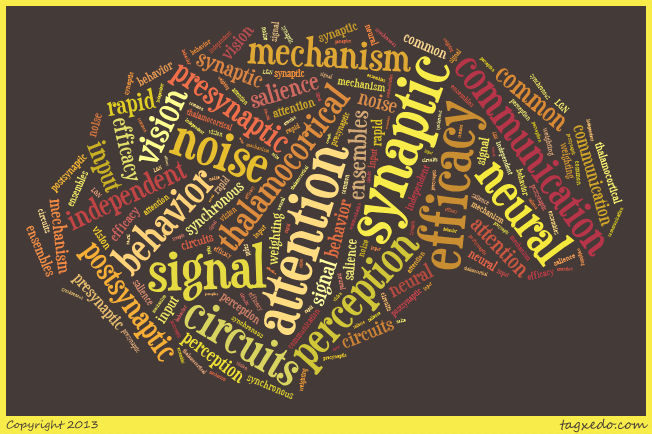Cellular mechanisms for attention in the brain found
July 31, 2013

A word cloud (“wordle”) created using keywords from Briggs, Mangun and Usrey “Attention Enhances Synaptic Efficacy and Signal-to-Noise in Neural Circuits” and shaped to an outline of an MRI of a human brain. Wordle creation assisted by Tagxedo.com. (Credit: Geisel School of Medicine at Dartmouth)
The ability to pay attention to relevant information while ignoring distractions is a core brain function. Without the ability to focus and filter out “noise,” we could not effectively interact with our environment.
But despite much study of attention in the brain, the cellular mechanisms responsible for the effects of attention have remained a mystery.
Researchers from Dartmouth’s Geisel School of Medicine and the University of California Davis studied communications between synaptically connected neurons under conditions where subjects shifted their attention toward or away from visual stimuli that activated the recorded neurons.
Using this highly sensitive measure of attention’s influence on neuron-to-neuron communication, they were able to demonstrate that attention operates at the level of the synapse to improve sensitivity to incoming signals, sharpen the precision of these signals, and selectively boost the transmission of attention-grabbing information while reducing the level of noisy or attention-disrupting information.
The results point to a novel mechanism by which attention shapes perception by selectively altering presynaptic weights to highlight sensory features among all the noisy sensory input.
“While our findings are consistent with other reported changes in neuronal firing rates with attention, they go far beyond such descriptions, revealing never-before tested mechanisms at the synaptic level,” said study co-author Farran Briggs, PhD, assistant professor of Physiology and Neurobiology at the Geisel School of Medicine.
In addition to expanding our understanding of brain, this study could help people with attention deficits resulting from brain injury or disease, possibly leading to improved screening and new treatments.
The research was supported by grants from the National Institute of Health’s (NIH) National Eye Institute (grant #s EY18683 to F.B., EY013588 to W.M.U.) and from NIH’s National Institute of Mental Health (grant # MH055714 to G.R.M.). Funding support also provided to G.R.M. and W.M.U from the National Science Foundation (grant #s BCS-0727115 and 1228535).